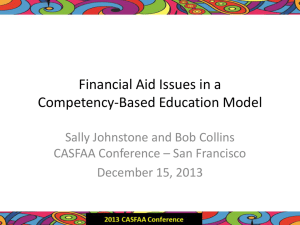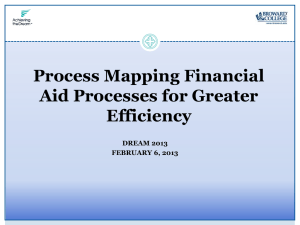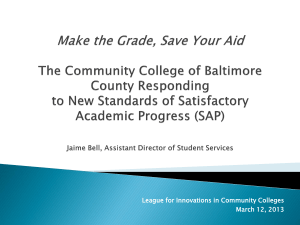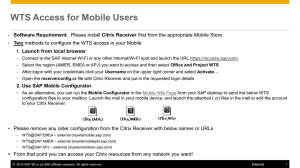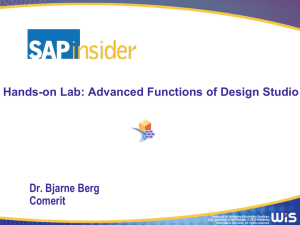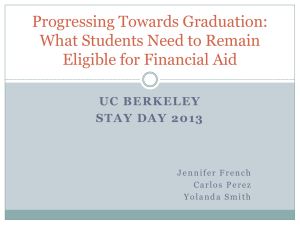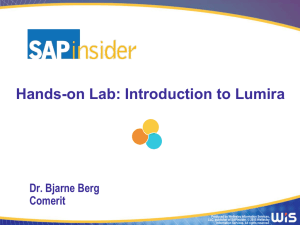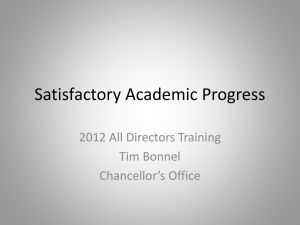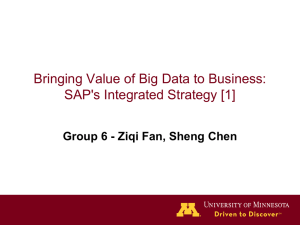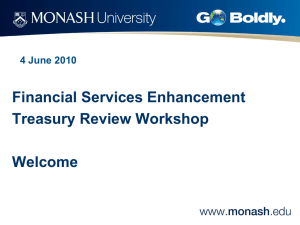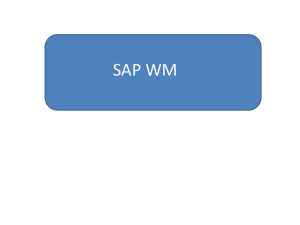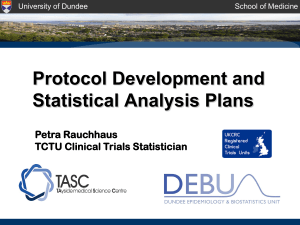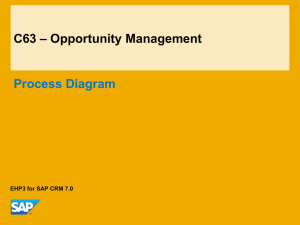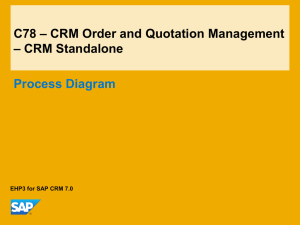Why Competency Based Education?
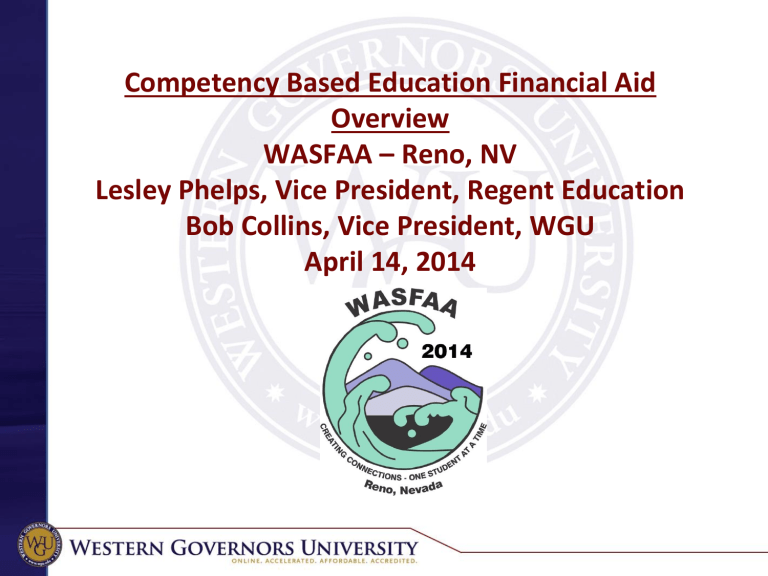
Competency Based Education Financial Aid
Overview
WASFAA – Reno, NV
Lesley Phelps, Vice President, Regent Education
Bob Collins, Vice President, WGU
April 14, 2014
What is Competency Based Education?
• The decoupling of seat time from academic progress
• Progress is evaluated on mastery of content/skills rather than seat time
• Student paced vs. defined semesters, quarters, etc.
Why Competency Based Education?
• More accurately measure student learning
• Reduce time to graduation
• Reduce costs
• Student loan debt 2 nd only to mortgage loans in total household debt
• Positioning for potential funding model and institutional ranking changes
• Enrollment considerations
Why Competency Based Education?
The Changing Needs of Learners
• Flexibility
• Changes in consumer behavior
• Changing demographics
• Increase in online learning
What are the challenges to implementing a
CBE program?
• Accreditation
• State coordinating and governing boards
• Accrediting agencies
• U.S. Department of Education
• Translation of competencies
• Faculty buy-in
• Resource support
• Title IV financial aid
5
Why in financial aid a hindrance to these models?
• Decoupling of seat time from academic progress...huh?
• Financial Aid Management (FAM) Systems are designed around the concept of structured periods of enrollment
• Non-Term Enrollment models designed for self-paced learning, but FAM systems not designed to manage resulting in manual processes:
• Increased compliance risk
• Slower service
• Labor cost considerations l 6
COMPETENCY-BASED EDUCATION
How can CBL be managed in an efficient and compliant manner?
• Need to carefully analyze systems limitations to determine what enrollment model will work for you
• Reach out to your colleagues on campus and financial aid colleagues at like institutions
• Ensure financial aid is a key stake holder from the beginning
Western Governors University
Founded in 1997
The principal mission of Western Governors
University is to improve quality and expand access to post-secondary academic opportunity by providing a means for individuals to learn independent of time or place and to earn competency-based degrees and other credentials that are credible to both academic institutions and employers .
Student Demographics
• Colleges: Information Technology, Business,
Teacher Education, and Health Professions
• Students are full-time, degree seeking at
Baccalaureate and Masters level
• Current enrollment > 44,000
• Most successful students:
– start with some college experience
– have work experience and motivation to earn degree
– average age is 36 years
Student Population
Growing Interest in CBE
Carnegie Foundation for the Advancement of
Teaching re-examining the ‘Carnegie Unit’
Foundations working with regional accreditors and Dept of Ed to assure financial aid for CBE
Gates Foundation supported project includes
WA, IN, FL & TX colleges as partners
Adapting and Adopting Competency-Based IT
Instruction to Accelerate Learning funded by
Department of Labor’s (TAACCCT)
Partner Colleges Developing CBE Programs
Austin Community College, TX
Broward College, FL
Sinclair Community College, OH
FL – Valencia College
IN – Ivy Tech Community College (Ft Wayne &
Lafayette)
TX – Lone Star Community College
WA – Bellevue College, Columbia Basin College,
Edmonds Community College, Community
College of Spokane
Design Principles for CBE
1) Degree reflects robust and valid competencies.
2) Students are able to learn at a variable pace and are supported in their learning.
3) Effective learning resources are available to students anytime and are reusable.
4) The process for mapping competencies to courses/learning outcomes/assessments is explicit.
5) The assessments are secure and reliable.
WGU Financial Aid Background
• HEA Reauthorization 1998 – eligible institution
• Distance Education Demonstration Program
– Competency-based Model
• Education Domains
• No Grades (Narrative Transcript)
• Unbundled Faculty Model (Mentoring and Assessment)
– Direct costs only in cost of attendance calculation
– Non-Term (6 month payment periods)
– SAP 100% successful completion every term
– Students start 365 days a year
– 100% Distance Education
WGU Financial Aid Background
• Lessons Learned
– Cost of Attendance (direct and indirect) – EFC = Need
– Introduction of Competency Units (CUs)
– Non-Standard Term – borrower based academic year
– 6-Month Terms begin on the first of each month
– Grades of Pass and Not Pass (not narrative, not pass/fail)
– 66.67% Cumulative Satisfactory Academic Progress (SAP)
– Flat term-based tuition to encourage acceleration
• Subscription model, fixed price per term regardless of CU’s
• Affordability of acceleration time to degree completion
Student Fraud Considerations
• WGU Orientation
– Begins the 15 th of each month
– Setting proper expectations – academic and financial
• Delay loan disbursement for all new students
– 30 day delay (45+ days of academic effort before $$$ )
• Duplicate address reports (US and E-mail, IP)
• Third party identity management/biometrics
• Verification of identity
– Notarized statement of educational purpose
Federal Financial Aid Delivery
• Academic Year (AY) – payment periods
– ED defines AY as minimum of 24 credits and 30 weeks
• Standard Term (Full-time, ¾ time, ½ time)
– Semester/Quarter/Trimester
– Fall/Spring and sometimes summer (header or trailer)
• Non-Standard Term (Full-time, ¾ and ½ time)
– Multiple entry points - Borrower Based Academic Year
• Non-Term and Clock Hour
– Full-time - successfully complete 24 credits or 900 hours
Measurement of SAP
Competency Based Model
• Degree Plan – no electives
• Academic Activity Verification (AAV)
• Qualitative Measure (Pass = B or better)
– Mastery of subject matter (3.0 GPA exceeds 2.5 required)
• Quantitative Measure
– Attempted versus completed
– Institutional policy on treatment of transfer credits
• SAP appeal approval requires Academic Plan
• On-Time Progress (OTP) to Graduation
– At least 12 CUs per six month term
SAP Overview
• Financial aid only awarded up to 150% of the program length
• At least 66.67% Cumulative SAP = Good Standing
• Less than 66.67% Term SAP = Warning
• New students less than 3 CUs per term = Terminated
• Termination and SAP Appeals
– Extenuating circumstances documentation & situation improvement
– If approved, must complete 100% until cum SAP > 66.67%
• Unintended consequences
• Meeting OTP in a term does not necessarily mean the student is meeting cumulative SAP requirements
• 12/20 = 60.00% - OTP is good, SAP is bad - discouraging
Other Regulatory
• Definition of Credit Hour 34 CFR 600.2
– www.ifap.ed.gov
Hot Topics - Program Integrity
• Distance Education Definition 34 CFR 600.2
– …support regular and substantive interaction between students and faculty
• Direct Assessment 34 CFR 668.10
– DCL GEN-13-10 (March 19, 2013)
• Return to Title IV (R2T4) 34 CFR 668.22
– Withdrawal date of determination
– Definitions of academic attendance, academic-related activity
